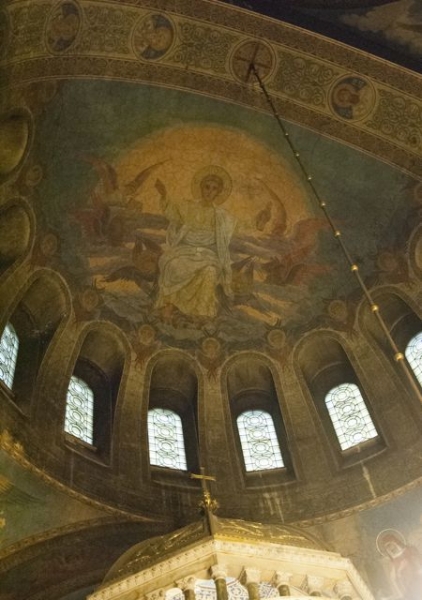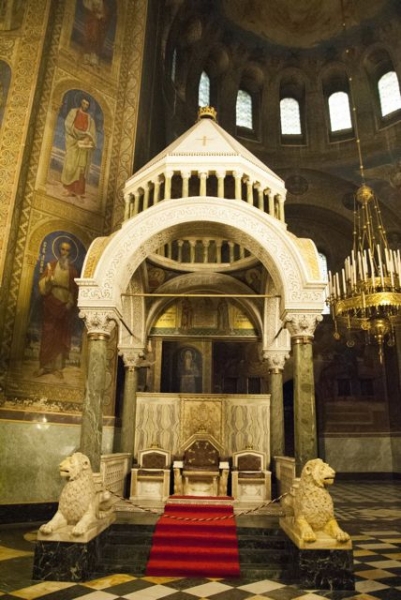Pictures - Polina Spartyanova
Polina Spartyanova
Father Anton is one of the youngest servants in the Orthodox Church of Alexander Nevski and yet he has no difficulty in officiating the afternoon liturgy in the largest Bulgarian cathedral. For him, the church is a reflection of the Third Bulgarian State. According to him, "This is not just a building, but greatness and Bulgarians have to prove that they deserve it."
In fact, the Alexander Nevski cathedral is a worthy convict of the new Bulgarian history, since its existence is a reflection of the rise and fall of Bulgaria in the last century.

Immediately after the liberation of Bulgaria from Ottoman rule in 1878, there was an idea to build a memorial in the name of St. Alexander Nevski, since he was the patron saint of the liberation of Bulgarian people - Tsar Alexander II. The church was erected in memory of the more than 200,000 soldiers who died for the freedom of Bulgaria and was designated as monument of Bulgarian liberation. Originally, the cathedral was to be built in Veliko Tarnovo, the capital of the Second Bulgarian Empire, but when Sofia was declared the new capital in 1879, Bulgarian Prince Alexander insisted that the monument should be erected there. The first stone of the church was laid in 1882 on part of the necropolis of ancient Serdica. A metal box with the names of the members of the government was built in the foundations of the memorial church as well as with the reasons for its construction.

The first project for the construction of the church of Alexander Nevski was created by architect Bogomolov, who was planning the erection of a much smaller church compared to the current one, which was to be built in a typical Russian style. The implementation of the project for the church, however, was delayed too much, and when its construction began in 1903, the Russian architect Alexander Pomerantzev made a brand new plan. In the project, he put suggestions similar in spirit and character to the Bulgarian and Byzantine architecture. Architect Pomerantzev had the support of Prince Ferdinand at the time and he was given the task of building a large ''royal cathedral'', although he had not been awarded the royal title at that time. Five years later, with the proclamation of the independence of Bulgaria, Ferdinand Saxe-Coburg was named "Tsar of Bulgaria".
In 1912 the church was completed, but due to the Balkan wars its sanctification was cancelled. During the First World War, when Russia bombed the Bulgarian city of Varna in 1916 as one of the Allies, the church was renamed St. Cyril and St. Methodius. But when the cathedral was sanctified in 1924 it was renamed St. Alexander Nevski.

The church is built on an area of 2,600 square metres and has a size of 70 to 55 metres. During a liturgy, it can seat about 5,000 people. The plastic decoration of the facades and interiors are reminiscent of the forms of decoration of Hagia Sophia in Instanbul and plastic Roman traditions. The bell tower is 52 metres high and there are 12 bells, which were made in Moscow. The largest bell weighs 12 tonnes, and the smallest – 10 kilogrammes and their chime can be heard within a radius of 15 kilometres.

The "royal cathedral" Ferdinand dreamt about had two thrones: a small bishop's throne, which was intended for the patriarch, and a great royal throne, which was intended for the tsar, the crown prince and the tsaritsa. However, no tsar sat on the latter because, after the end of the First World War, Ferdinand abdicated in favour of his son Boris III, and the new crown prince did not like the monarchical form of government, nor did he adhere to its traditions. During the communist regime the royal throne was hidden in the altar of the church.
During the Second World War, when Sofia was bombed by the anti-fascist coalition, several bombs fell in the northern part of the church, but they were not direct hits and the church was not seriously affected compared to the rest of the capital city. Before the start of the bombing, the icons of the memorial church were removed to the Rila Monastery, in order to avoid their destruction. But after the war and the establishment of the communist regime in Bulgaria the restoration of the Orthodox memorial church St. Alexander Nevski remained in the background. During one of his visits to Sofia in the early 1950s, Marshall Voroshilov wondered how this "monument of Soviet culture" had not been recovered from the bombing yet, and only after that the government allocated funds for its restoration.
Nowadays, Alexander Nevski Church is the largest Orthodox Church in Bulgaria and the second largest in the Balkans after the Serbian Saint Sava in Belgrade. Over the past two decades, the management of the memorial church sought various options for the restoration of the church and especially its wall-paintings which have darkened with time. According to Father Anton, there are many people who would like to join the fundraising campaign for the restoration of the interior of the church, but there are too many problems related to its ownership, since the Church has no notarial act for it.
